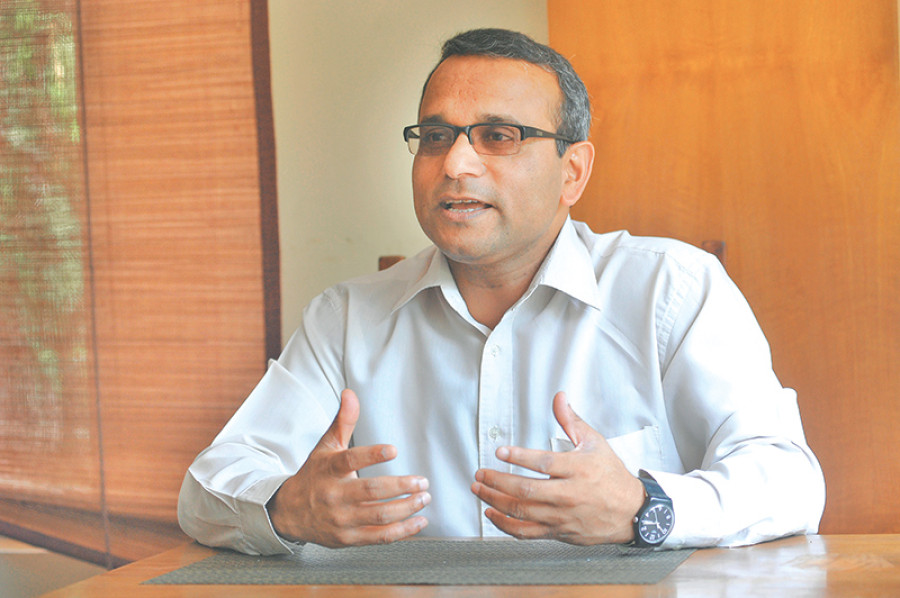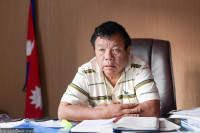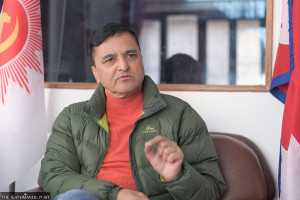Interviews
'Madhesi rights movement will continue even though RJP-N has entered elections'
Conducting polls before the constitutional mandated time of January 2018 is viewed as a major step in legitimising Nepal’s new constitution. Agitating Madhes based parties too have agreed to participate in the elections, starting with Phase 3 of the local level elections in Province 2.
Kabindra Purush Dhakal
Conducting polls before the constitutional mandated time of January 2018 is viewed as a major step in legitimising Nepal’s new constitution. Agitating Madhes based parties too have agreed to participate in the elections, starting with Phase 3 of the local level elections in Province 2. This agreement and compromise has helped assure people of the completion of polls. Tula Narayan Shah is a Madhesi rights and political activist, and executive director of the Nepal Madhesh Foundation. Mukul Humagain and Kabindra Purush Dhakal talked with Shah to hear his views on the Madhes movement and Madhesi parties’ decision to contest in the upcoming elections.
What message will the completion of polls in Province 2 convey to the members of the public?
The Madhesi movement is fuelled by the demand that the constitution ensure equal rights for all. The movement is against the non-inclusiveness nature of the constitution and to pressure lawmakers into endorsing minority rights. A large number of Madhesis have become involved in these protests, showing the clear need for constitutional amendment. However, fair amendments have yet to materialise.
The state is controlled by those individuals who control policies, decisions, and opinions. And in Nepal, this control is primarily in the hands of major ethnic groups. Owing to this dominance, amendments satisfactory for minority groups are yet to be made. If these amendments for inclusiveness are pushed through, the current pattern of dominance would change. The state leaders do not want this to happen, which is why Madhesi rights have not been seriously addressed.
In my opinion, the elections are a game and the constitution and law set the rules to this game. The problem is that these rules are biased against minorities, hence chances of them winning in elections are slim. This is why they have taken to the streets. But these protests haven’t been successful and now minorities are forced to play along.
Now the Rastriya Janata Party-Nepal is contesting polls in Province 2 despite the fact that their demand for constitution amendment has not been fulfilled. Why has this change occurred?
To answer this, we have to first analyse what the RJP-N is, how it was formed, and what are its motives. We don’t have to hide the fact that the party was formed overnight with the help and direction of a foreign power. The other thing is that the RJP-N has not been able to prop itself up as a national party. The RJP-N was formed to bolster the Nepali Congress (NC)-Maoist Centre (MC) alliance so they could secure a majority. Foreign powers also wanted to influence our national politics to a certain extent.
The NC-MC alliance committed to passing amendments as per the RJP-N demands in exchange for their support, but the two parties could not ensure a two-thirds majority in Parliament required to amendment the constitution. It was in the face of this predicament that the RJP-N launched movements. Now, however, the RJP-N seems to have realised that not participating in Phase 3 local elections could prove detrimental to the status of the ruling coalition and perhaps even result in change of government.
How is the public construing the RJP-N’s agreement to partake in elections even after the constitution amendment failed to pass through Parliament?
While the RJP-N is seen as the leader for this phase of the movement, the movement for rights started before the RJP-N was formed, and it also had roots before there were any Madhes-centric political parties. The latest movement started in 2015 after the signing of the 16-point agreement between major political parties for the new constitution, the Madhesi political parties joined the movement after this.
The nature of the main political parties is that they focus only on service deliverance. In such a political system, the performance of the government depends on the person leading it, but the system and the game remains the same. However, the politics of the Madhesi, Tharu, Janjati and Dalit is of constitutional reform. They are looking towards a structural change in the status quo and the governance system which can only be brought forth through amendments to the constitution. The Madhesis and other minorities take to the streets to have their voices heard, and the government and lawmakers need to listen to their voices to amend the constitution.
If the RJP-N enters the election scene at this juncture, voters will be confused. They will be seen as joining the Madhesi Janadhikar Forum and major political parties, thus abandoning their fight for structural change.
Who do you think will succeed in the elections?
There are multiple factors that decide who wins an election: 1) Personality of the candidate 2) Party organisation 3) Economic status of the candidate and party 4) The relation between the candidate’s party and the state and 5) The ethnicity of the candidate relative to electoral constituency.
There have been three parliamentary and two constitutional elections since 1990 in and around Province 2. In 2008, there were strong Madhesi movements, and the Madhesi Janadhikar Forum won 16 seats. This was at a time when Madhesis were emotionally charged to make a change in politics. Even then, the NC came second in this region. However, the party factor is only one of the five factors that win elections in Nepal. NC is the strongest party, but this is trumped by ethnicity/caste. In Nepal there are three social clusters—Khas-Arya, Janajati, and Madhesi—and all these groups vote. Madhesi and Janjati used to be only voters, whereas Khas-arya were voters and leaders. However, this scenario has changed and now Madhesis and Janjatis are trying to change from being just voters to representatives in the political landscape.
Post 1990, Nepal’s voters have largely been split into two groups—democratic and leftist. Before 2007, the NC used to sweep the democratic vote and the CPN-UML used to sweep the leftist vote. More recently we see that the left has been divided between the CPN-UML and the MC, while the NC is sharing the democratic voter bank with the Madhesi parties.
It makes sense for the MC and the NC to forge an alliance, as they have separate vote banks and can increase their combined strength in Parliament. It would also make sense for the Madhesi parties to form a coalition with the CPN-UML to counter the NC as a democratic vote bank contender. But instead they have branded the CPN-UML as the enemy and are leaning towards the MC-NC coalition. So why would Madhesis vote for Madhesi parties if these parties form a coalition with the NC and MC? There is no concrete difference between the Madhesi parties and others; none of these parties have been able to deliver equal rights.
Interestingly, the RJP-N has slammed the MC the most in its election manifesto. Is it just an election tactic or does it have long term political significance?
First of all, manifestos in Nepal and especially in this context do not hold much significance. They are produced considering that no one will ever read them. Proper research and consultative work is never done when they are drafted. The current movement arose because the constitution was drafted in a manner that ignored the rights of the minorities. All parties—the CPN-UML, the MC and the NC—had a hand in this. So there is no logic behind the Madhesi parties forming alliances with some parties while treating others as adversaries.
However, it has to be understood that the Madhesi movement was a by-product of the Maoist movement. In identifying issues that are detrimental to Nepalis, the Maoists discovered problems with the way Madhesis were treated in Nepal, claiming “internal colonisation is the major problem of Madhesi community”. This helped instil zeal in the Madhesis who then lent their support to the MC to right these wrongs. But post 2006, the Maoists missed the target completely while forming the interim constitution.
All three parties might differ in which strategic power they are serving or what governmental agenda they own up to. However, as a Madhesi rights activist, I see no difference in these three parties. All three major parties have basically shown that they want to maintain a societal and political status quo.
The RJP-N was seen as the major Madhesi force for the movement, how do you think that this will move forward now?
Initially, the RJP-N stepped up to take charge of the movement, but as soon as they decided to join elections, they effectively left the movement. But the movement for Madhesi rights will continue regardless of whether the RJP-N enters elections and regardless of electoral results.
Leadership, agenda and organisation are of paramount importance for a successful protest movement, so one cannot know exactly how or when the Madhesi movement will resume and in what form. But if the agenda holds true, then leadership and organisation will materialise in due time.
It has to be understood that Madhesis and other minorities are fighting for equal rights. This is a structural and political issue, based on caste, colour, race and language. These are the specific areas where the Madhesi movements want equality and reform. And this fight will continue until demands are adequately addressed.




 20.12°C Kathmandu
20.12°C Kathmandu












